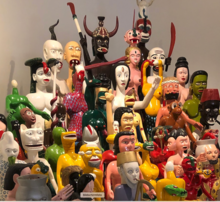Museum der Völker






The Museum der Völker in the Austrian Schwaz in the county of Tyrol was founded in 1995 as a cultural association Haus der Völker by Gert Chesi and belongs to the well known Ethnology museums in Europe. After a new construction and remodeling the exhibition operation opened on the 12th of April 2013 as Museum der Völker. Translated the name means museum of the peoples or museum of the tribes.
History
Gert Chesi, photographer, journalist and author, had collected more than a thousand exhibits from all over the world in the period of fifty years. The art objects are the base of the Museum operation and give an insight into the religious and artistic creation of mankind.[1][2]
Cultural Club
Today the cultural club Museum der Völker runs the museum. Art objects from distant cultures determine the Museum: Stone sculptures of Khmer, Buddha images from many eras, terracotta figures of the Nok, ancestral figures of the Dajak, grave finds from China and old bronzes from South-East Asia are displayed in addition to contemporary Voodoo objects and utensils of animism.[3][4]
Exhibitions
Artifacts from over a period of four thousand years ethnographic exhibits from four themes will be presented to the public:
- Africa
- Asia
- Archaeology
- Afro-American syncretism
Collections
Currently, the collection Chesi / Stadt Schwaz, the Schell Collection, as well as the Lindner collection are displayed at the Museum der Völker.
Special Show
In two rooms, special exhibitions are hosted regularly. These show ethnographic collections and contemporary non-European art to photographic works.
- 2010 Schätze aus dem Depot[5]
- 2010: Textile Kunst aus Afrika[6]
- 2010: Das Erbe Chinas
- 2011 Feuer und Erz – Schmiede und Gießer in Afrika[7]
- 2011: Afrikas Moderne im Spiegel der Generationen[8]
- 2011: Wohnen mit den Ahnen[9]
- 2011: Jubiläumsausstellung 15 Jahre Haus der Völker[10]
- 2012: Magische Stoffe – gewobene Träume – Kunstvolle Textilien aus Indonesien[11]
- 2013: Sangomas – Traditionelle Heiler Südafrikas, Fotografien von Peter Frank [12]
- 2013: Geistermasken aus Thailand[13]
- 2013: AFRIKA HEUTE!
- 2014: Söhne und Töchter des Windes – Die letzten Nomaden Afrikas, Fotografien von Mario Gerth[14]
- 2014: Kunst und Magie in Silber und Seide – Schmuck und Textilien chinesischer Bergvölker[15]
- 2014: Dogon, Kunst und Mythos in Zusammenarbeit mit Jan Baptist Bedaux[16]
- 2015: Tanzende Schatten - Marionetten, Puppen und Masken aus Asien[17]
- 2015: Burma - Meisterwerke des Buddhismus[18]
- 2015: Susanne Wenger - Ein Leben mit den Götterm[19]
- 2015: Zauber der Weltkulturen 20 Jahre Museum der Völker[20]
- 2015: Das Gedächtnis der Steine - Seltene Steinreliefs und Figuren aus Asien[21]
- 2016: Das Böse - Exponate aus Schwarzmagischen Kreisen[22]
- 2016: Yoruba - Meisterwerke einer Afrikanischen Hochkultur, Samstag[23]
- 2016: GLADYS - Der Maler und seine Geister - Zeitgenössische Malerei aus Benin[24]
- 2016: DAS GEHEIME KAMERUN - Fotografien von Henning Christoph [25]
- 2016: AFRIKA IM GEWAND - Bunte Textilvielfalt eines Kontinents[26]
- 2016/2017: Indonesien – Kunst und Kult vom Inselreich
- 2016/2017: Bali – Insel der Götter
- 09.09.2017 - 11.03.2018: Leon Pollux "Menschen"
- 09.09.2017 - 18.11.2018: Zwischen Eigensinn & Anpassung
- 17.03.2018 - 2019: Unvergessen machen
- 05.05.2018 - 18.11.2018: Maasai – Baumeisterinnen aus Ololosokwan
- 22.06.2018 - 18.11.2018: Schulprojekt und Ausstellung "Mein, dein, unser Raum"
- 08.12.2018 - 18.08.2019: UNGEHEUER WILD
Documentary Film
please refer Gert Chesi
Decoration
1999, the Museum der Völker received the Tyrolean Museum prize[27]
1999 Recognition Award of the Austrian Federal Ministry for Arts and Culture [28]
2014 ICOM Austria, Österreichisches Museumsgütesiegel[29]
References
- ^ Tiroler Tageszeitung 23. August 2008
- ^ DiePresse 15. April 2013
- ^ Frankfurter Rundschau 23. August 2008
- ^ ORF 12. April 2013
- ^ Kultur Tirol, retrieved, 19 August 2014 Archived 19 August 2014 at the Wayback Machine
- ^ Kultur Tirol, retrieved, 19 August 2014 Archived 19 August 2014 at the Wayback Machine
- ^ Kultur Tirol, retrieved, 19 August 2014 Archived 19 August 2014 at the Wayback Machine
- ^ Kultur Tirol, retrieved, 19 August 2014 Archived 19 August 2014 at the Wayback Machine
- ^ Kultur Tirol, retrieved, 19 August 2014 Archived 19 August 2014 at the Wayback Machine
- ^ Tirol Infos, retrieved, 19 August 2014
- ^ Tiroler Tageszeitung 24. Januar 2012
- ^ Kultur Tirol, retrieved, 19 August 2014 Archived 19 August 2014 at the Wayback Machine
- ^ Kultur Tirol, retrieved, 19 August 2014 Archived 19 August 2014 at the Wayback Machine
- ^ Tiroler Tageszeitung 4. August 2014
- ^ Tiroler Tageszeitung 26. Mai 2014
- ^ Tiroler Tageszeitung 21. Oktober 2014
- ^ Bezirksblätter 7. Februar 2015
- ^ Tiroler Tageszeitung 20. April 2015
- ^ Tiroler Tageszeitung 17. Juni 2015
- ^ Bezirksblätter 13. August 2015
- ^ Bezirksblätter 7. November 2015
- ^ Tiroler Tageszeitung 14. Januar 2016
- ^ 27. April 2016
- ^ Bezirksblätter 3. September 2016
- ^ Bezirksblätter 12. September 2016
- ^ Bezirksblätter 16. September 2016
- ^ Liste Museumsauszeichnungen Tirol Stand 2014 Archived 2014-08-19 at the Wayback Machine
- ^ Anerkennungspreis Österreich 1999 Archived 2014-10-21 at the Wayback Machine
- ^ Österreichisches Museumsgütesiegel 2014
